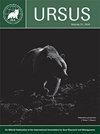Female brown bears use areas with infanticide risk in a spatially confined population
IF 0.6
4区 生物学
Q4 ZOOLOGY
引用次数: 15
Abstract
Abstract: Areas used by female brown bears (Ursus arctos) with cubs-of-the-year (hereafter, FCOY) during the first months after den exit are crucial for offspring survival, primarily because of the risk of infanticide by male bears. Therefore, FCOY may avoid areas frequented by adult males during the mating season. The main aim of this study was to identify landscape features (i.e., structure, composition, and human footprint) that may differentiate the habitat use of FCOY in the small bear population of the Cantabrian Mountains (northwestern Spain; 2001–2016) from (a) areas frequented by females with yearlings, because older cubs are at less risk of infanticide than cubs-of-the-year, and (b) bear mating areas (i.e., the riskiest areas for FCOY because of the presence of adult males). During the first months after den emergence (Apr–Jun), FCOY settled in the roughest areas of the Cantabrian Mountains at most spatial scales. This settlement pattern might represent a behavioral adaptation of FCOY to reduce the risk of encounters with males during the mating season. However, FCOY also settled in similar landscapes to those used by adult bears during the mating season, which may increase the likelihood of risky encounters. Indeed, we observed a spatial overlap between observed locations of FCOY and mating areas, which may help explain the high frequency of infanticide observed in the Cantabrian Mountains. We hypothesize that the need for both shelter and food in early spring may ‘trap’ FCOY in otherwise favorable areas that overlap with mating areas. This may occur predominately in small and confined bear populations, such as the one in the Cantabrian Mountains, where a restricted range and limited habitat availability might prevent FCOY from avoiding risky areas successfully.在种群数量有限的情况下,雌性棕熊会选择有杀婴风险的区域
摘要:母棕熊(Ursus arctos)在出穴后的头几个月生育幼崽的区域对其后代的生存至关重要,主要是因为雄性熊有杀婴的风险。因此,FCOY可能会在交配季节避开成年雄性经常光顾的区域。本研究的主要目的是确定景观特征(即结构、组成和人类足迹),以区分坎塔布连山脉(西班牙西北部;2001-2016年)来自(a)有一岁幼崽的母熊经常光顾的地区,因为年龄较大的幼崽比同龄幼崽的杀婴风险更低,以及(b)熊交配区(即,由于成年雄性的存在,FCOY最危险的地区)。在巢穴出现后的最初几个月(4 - 6月),FCOY在大多数空间尺度上都定居在坎塔布连山脉最崎岖的地区。这种定居模式可能代表FCOY的行为适应,以减少在交配季节与雄性相遇的风险。然而,FCOY也定居在与成年熊在交配季节使用的相似的景观中,这可能会增加危险遭遇的可能性。事实上,我们观察到在观察到的FCOY地点和交配区域之间存在空间重叠,这可能有助于解释在坎塔布连山脉观察到的高杀婴率。我们假设,早春对住所和食物的需求可能会将FCOY“困”在与交配区重叠的其他有利区域。这可能主要发生在小而受限的熊种群中,例如坎塔布连山脉的熊种群,在那里,有限的范围和有限的栖息地可能会阻止FCOY成功地避开危险地区。
本文章由计算机程序翻译,如有差异,请以英文原文为准。
求助全文
约1分钟内获得全文
求助全文
来源期刊

Ursus
生物-动物学
CiteScore
2.00
自引率
15.40%
发文量
12
审稿时长
>12 weeks
期刊介绍:
Ursus includes a variety of articles on all aspects of bear management and research worldwide. Original manuscripts are welcome. In addition to manuscripts reporting original research, submissions may be based on thoughtful review and synthesis of previously-reported information, innovative philosophies and opinions, and public policy or legal aspects of wildlife conservation. Notes of general interest are also welcome. Invited manuscripts will be clearly identified, but will still be subject to peer review. All manuscripts must be in English. All manuscripts are peer-reviewed, and subject to rigorous editorial standards.
 求助内容:
求助内容: 应助结果提醒方式:
应助结果提醒方式:


